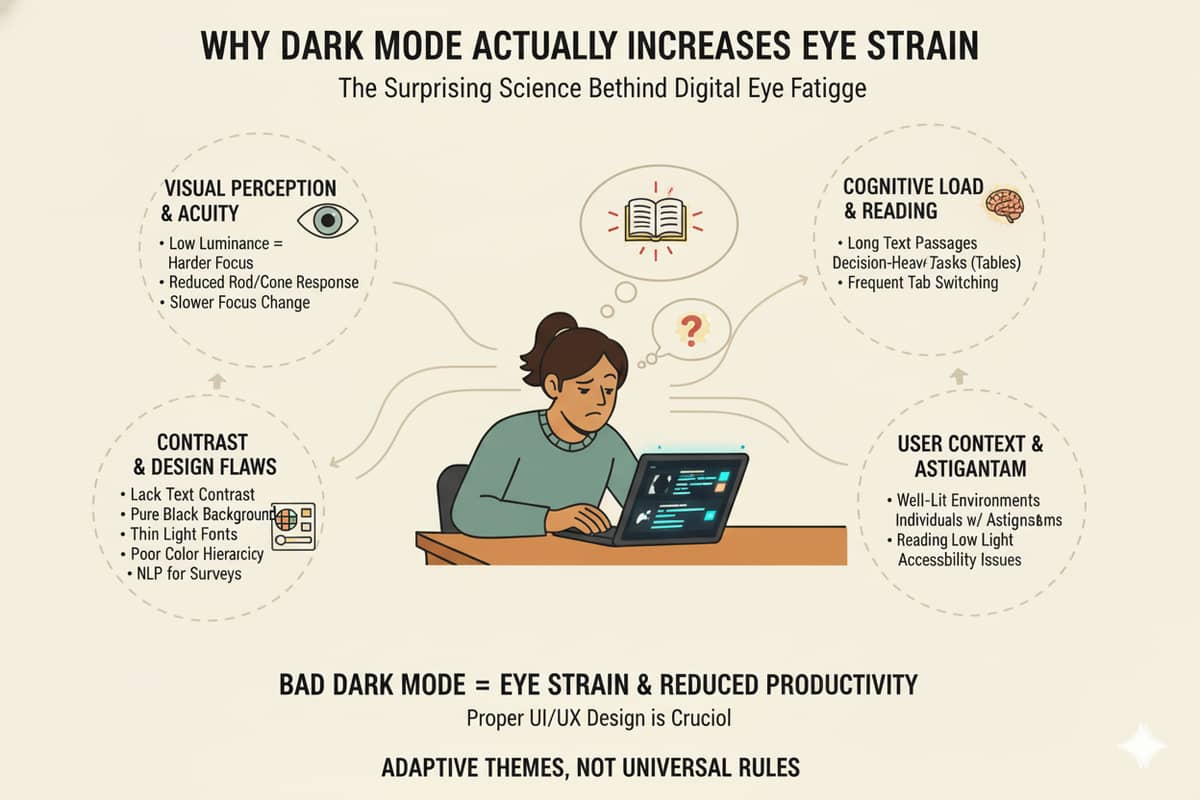Introduction
Dark mode is one of the most popular UI options in the current applications. It will offer less eyewear, enhanced battery life, and a more comfortable experience to look at. However, recent research has shown that dark interfaces can be a cause of eye fatigue in a good number of users, particularly when using the interface for long reading or decision-making. This is not only because of brightness but also because of cognitive load, visual acuity, screen contrast, and user context.
This poses a critical problem to businesses, designers, and teams of products: when do we use dark mode, and when will it be counterproductive? This knowledge enables organizations to develop more balanced digital experiences and an appropriate visual path to large audiences of users.
This blog explores the real science behind dark mode discomfort and what UI/UX teams must consider before adopting it.
Visual Perception and Why Dark Mode Strains the Eyes
The eyes of humans are adjusted towards bright light, and the digital screens do not react as natural light. This is the reason why dark backgrounds may occasionally increase and not decrease eye stress.
Key Visual Factors Behind Eye Strain
- Low luminance makes the eyes work harder to read small text or interface elements, causing micro-fatigue.
- Rod and cone cells respond differently under low light, reducing visual acuity and slowing focus changes.
- To read low-contrast text, users have a habit of squinting to decode it, particularly in thin fonts or large passages.
- High-contrast interfaces make the eyes change between light text and dark backgrounds and cause more visual noise.
This is where many businesses reconsider how digital platforms should adapt UI themes. A balanced approach often requires inputs from a professional UI/UX design agency, ensuring scientific and user-tested design decisions rather than assumptions.
When Dark Mode Fails for Productivity and Reading
Dark mode is ideal for entertainment content, dashboards, and occasional interaction. But for detailed reading and productivity tasks, it becomes counterproductive.
Situations Where Dark Mode Increases Cognitive Load
-
Reading long text passages or documentation for extended periods
-
Performing decision-heavy tasks like evaluating data, forms, or tables
-
Switching between multiple tabs or performing context shifting
-
Users working in well-lit environments where dark mode creates imbalance
-
Individuals with astigmatism who struggle with low-light focus
Because of this, many companies rely on a UI/UX design company to run controlled usability tests before launching large-scale product redesigns. Data makes the decision more trustworthy than user preference polls alone.
Design Mistakes That Make Dark Mode Harmful
Dark mode is not an issue; it is a bad implementation of dark mode. The majority of the eye-strain problems are attributed to preventable design errors.
Common Dark Mode UX Issues
- Lack of contrast between background and text foreground.
- Excessive usage of pure black (#000) makes the whites glare around.
- Thin, light-weight typefaces that disappear in low luminance
- Poorly tuned color accents that reduce information hierarchy
- Interface elements not optimized for accessibility standards
- Dark mode applied universally instead of contextually
Designers working on dark interfaces require strong visual, accessibility, and readability principles. This is why organizations often hire specialists or a UI/UX design services team to ensure consistency across platforms.
Conclusion
Dark mode is not harmful in itself, and it is misconceived. It performs very well in a low-light environment, with a media-based interface and a single burst interaction. Nonetheless, when the workflow needs to be widely read, make many decisions, and be highly productive, dark mode may contribute to the strain on the eye, as the level of detail visibility is low, the visual acuity is poor, and overall design decisions are poorly executed.
The dark mode should not be viewed as a magical tool by business owners, product teams, and tech leaders. Rather, effective design in UI/UX incorporates adaptive themes, accessibility testing, and interface strategy. This ensures that users get visual comfort instead of fatigue and that digital products support productivity rather than hinder it.

